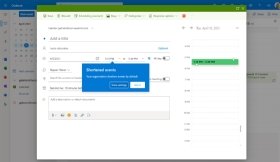Business practices that could ease meeting fatigue (original) (raw)
Researchers say breaks between meetings and team-building activities that give employees a sense of belonging help combat fatigue in the hybrid workplace.
New research suggests that companies should rethink how they structure and schedule meetings to prevent employee fatigue and bolster teamwork in the emerging hybrid work environment.
This week, Microsoft released research findings that found people benefit from 10-minute meditation breaks between meetings. The pause resulted in lower stress levels and more participation in discussions. The company based its conclusions on the brain activity of 14 people who joined back-to-back meetings with and without breaks.
The American Psychological Association (APA) reported that workers who felt they played an essential role in a team were less likely to suffer video-conferencing burnout. The APA based its findings on five days of hourly surveys taken by 55 U.S. workers in various industries.
The studies show that fostering employees' mental well-being in a work environment of in-office and at-home workers will require changes in meeting practices. The APA's recommendations included encouraging friendships within teams through small talk before or after meetings and informal sessions for discussing personal interests. The association also encouraged scheduling early afternoon meetings, when workers had the most energy.

Microsoft's Outlook feature lets organizations schedule shorter meetings by default.
"A lot of making a connection with others is up to the people in the group -- meaning technology alone can't make it happen," said Andrew Bennett, the lead researcher in the APA study. Bennett is an assistant professor at Old Dominion University in Norfolk, Va.
Gartner analyst Mike Fasciani said companies should discourage overscheduling -- a typical worker practice during the COVID-19 pandemic -- and replace video meetings with messaging when possible. Also, meeting organizers should invite only people who need to attend.
"As long as you're invited to meetings that you are an active participant in ... you're going to be more energized and motivated," Fasciani said.
While technology can't solve meeting exhaustion, it can help. Microsoft recently launched an Outlook feature that lets employees and organizations set scheduling defaults that shorten meetings so that people can take breaks between sessions.
By the end of April, Microsoft will let people use its Teams collaboration service to set aside time at the end of the workday to wrap up tasks and wind down as they transition into personal time -- something it calls a virtual commute.
Zoom has added features to its video-conferencing service meant to add a little fun to meetings. The company expanded the number of in-meeting emoji reactions and launched video filters that let participants wear eye patches or 3D glasses.
Mike Gleason is a reporter covering unified communications and collaboration tools. He previously covered communities in the MetroWest region of Massachusetts for the Milford Daily News_,_ Walpole Times_,_ Sharon Advocate and Medfield Press_. He has also worked for newspapers in central Massachusetts and southwestern Vermont and served as a local editor for_ Patch_. He can be found on Twitter at @MGleason_TT._
Next Steps
Video conferencing vendors rush to fix meeting fatigue
 A look at expectation vs. reality of generative AI in 2024
A look at expectation vs. reality of generative AI in 2024  By: Esther Shittu
By: Esther Shittu  Frontline worker jobs at risk from AI surge
Frontline worker jobs at risk from AI surge  By: Patrick Thibodeau
By: Patrick Thibodeau  Enterprise applications of the metaverse slow but coming
Enterprise applications of the metaverse slow but coming  CMS Sued by Ten States Over Vaccine Mandate for Healthcare Workers
CMS Sued by Ten States Over Vaccine Mandate for Healthcare Workers